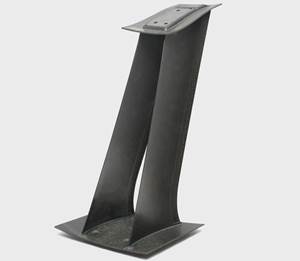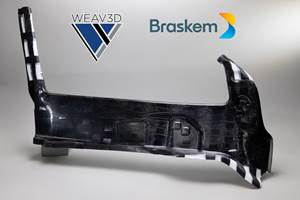A 2004 SAMPE Europe/JEC Composites Show post-show review
Paris Technical Conference marks SAMPE Europe's 25th Anniversary with myriad new developments.
Paris was the stage as SAMPE Europe celebrated its 25th Anniversary Jubilee, at the annual SAMPE Europe/JEC 2004 Conference and Exhibition (March 31-April 2). Festivities included a Gala Dinner and welcome reception for SAMPE Europe Conference attendees on March 31 at Les Salons Hoche, near the city's famed Arch de Triumph.
Conference keynoter Dr. Frances Abrams, of the U.S. Air Force Materials Laboratory, addressed "Composites Manufacturing for Affordable Structures," advocating a "reverse building block" approach to materials/ structures testing, in which the testing and validation sequence begins with a finished or nearly completed structure. She contended that because most of the available program funding is typically expended on basic materials coupon testing, relatively little money remains for the critical final development stages. Dr. Abrams pointed out that, today, the source of developmental problems is rarely the coupons and small part prototypes. Rather, the significant challenges tend to crop up when components are assembled into the finished structure.
At the standing-room-only JEC "User's Forums," Dr. Patrick Kim of DaimlerChrysler addressed the use of carbon fiber from the large automotive OEM perspective. Noting that carbon's use in supercars does not automatically mean it will be used in larger-volume passenger cars, Kim asserted that to make such a leap, the auto industry would need new molding processes that could enable cost-effective fabrication in volumes of 10,000 and 30,000 units per year.
Parisian product showcase
On the JEC exhibit floor, the HPC staff found the following standouts:
At the A&P Technology (Cincinnati, Ohio, U.S.A.) stand: Zero, a nonwoven unidirectional reinforcement with a very low percentage of binder material, designed for Lockheed Martin's F-22 program and now in use in boatbuilding and recreational applications. Also new: Bimax biaxial fabric, offered with +/-45° fiber orientation, and Trimax, a triaxial fabric offered in either 0°, +/-45° or 0°, +/-60° fiber orientation within a single layer. The fabric also can be customized to specific widths and areal weights.
Research-and-development company Biteam (Sagostigen, Sweden) illustrated its Dual-Directional Weaving concept, which interlaces a multilayer warp with vertical and horizontal sets of multiple weft to form complex, networked 3-D fabric structures that can be engineered to form damage-tolerant, net-shape fiber shells, tubes and solid preform profiles, in straight or curved lengths.
Stesalit (Zullwil, Switzerland) continued its focus on the promotion of its specialized range of prepregs for aircraft and space vehicles. Also available was detailed information on the company's range of flame-retardant, low-smoke and heat-release prepregs, developed specifically for the rail industry.
IMS (Worb, Switzerland) premiered its new, fast-reacting H0.11 epoxy resin for prepreg. This formulation reacts within 3 to 5 minutes, at 130°C/266°F, reportedly reducing process times across a wide range of composites applications.
Huntsman Advanced Materials (Duxford, Cambridge, U.K.) launched an epoxy wet layup system for the recreational and composite repair markets. The system features adjustable reactivity, and combines Araldite LY 3297 resin with either Aradur 3298 or Aradur 3299. Meanwhile, the company's RenShape Solutions division presented new RenGel, RenLam and RenInfusion laminating and infusion systems used to make large aerospace tooling.
Nippon Graphite Fiber (Cypress, Calif., U.S.A.) presented its new XN-100 chopped and milled carbon fiber for compounding and thermal conductive sheet applications. The fiber offers thermal conductivity over 900 W/mK, can be used with compression and injection molding, and, according to the company, is available at a competitive price.
Weaver Oxeon AB (Gothenberg, Sweden) spotlighted its TapeWeaving Technology, a new alternative to standard methods for producing plain-weave carbon, aramid and glass fabrics. Also useful in weaving brittle boron and ceramic fibers, the new method reportedly interlaces 20-mm to 50-mm wide (0.79-inch to 2.0-inches wide) unidirectional tapes, rather than yarns, yielding fabrics as wide as 1,500 mm/59 inches, in a range of weights as low as 100 g/m². Advantages reportedly include increased part surface smoothness, good drapability and conformation to complex contours.
RocTool (Le Bourget du Lac, France and Atlanta, Ga., U.S.A.) demonstrated its Cage System molding process, featuring an inductive heating system that surrounds the mold. The inductors generate an electromagnetic field that produces electrical current capable of heating the mold surface instantly. Benefits include comparatively lower energy consumption and reduced cycle times because the system requires no preheating.
Zoltek Europe (Schwaig, Germany) reported automaker BMW's formal acknowledgement that PANEX fibers meet its performance requirements. Zoltek expects to partner with BMW in the development of a series-production automobile with all-carbon composite structural components. According to the company, most large wind blade manufacturers have tested and certified the fibers for their blades, with one order for 220,000 lb of fiber already received. The company's subsidiary, Entec Composite Machines, reported a $2.6 million (USD) contract award, to build equipment for automated fabrication of wind blades. ,
And that's just a sampling of what was on display in Paris. See our SAMPE U.S. Show wrap up, p. 22, for additional new product introductions. And mark your calendars: The 2005 JEC Composites Show convenes next year, April 5-7, in Paris.
Related Content
PEEK vs. PEKK vs. PAEK and continuous compression molding
Suppliers of thermoplastics and carbon fiber chime in regarding PEEK vs. PEKK, and now PAEK, as well as in-situ consolidation — the supply chain for thermoplastic tape composites continues to evolve.
Read More3D weaving capabilities achieve complex shapes, reduce weight and cost
JEC World 2024: Bally Ribbon Mills is displaying film-infused 3D woven joints, woven thermal protection systems (TPS) and woven composite 3D structures.
Read MoreBraskem demonstrates PP solutions using Weav3D composite lattice technology
Partnership combines Braskem’s polypropylene sheets with Weav3D Rebar for Plastics technology to address new structural, automotive applications requiring high-strength, lightweight material solutions.
Read More3D-woven composites find success in aerospace, space
CAMX 2024: Bally Ribbon Mills experts are displaying the company’s various joints, thermal protection system (TPS) technologies and other 3D woven composites for mission-critical applications.
Read MoreRead Next
All-recycled, needle-punched nonwoven CFRP slashes carbon footprint of Formula 2 seat
Dallara and Tenowo collaborate to produce a race-ready Formula 2 seat using recycled carbon fiber, reducing CO2 emissions by 97.5% compared to virgin materials.
Read MoreVIDEO: High-volume processing for fiberglass components
Cannon Ergos, a company specializing in high-ton presses and equipment for composites fabrication and plastics processing, displayed automotive and industrial components at CAMX 2024.
Read MoreDeveloping bonded composite repair for ships, offshore units
Bureau Veritas and industry partners issue guidelines and pave the way for certification via StrengthBond Offshore project.
Read More





















